交通运输与物流专业英语(Unite 7)中英文(精编文档).doc
Unit 7 Logistics Transportation

Unit Seven Logistics TransportationPart One TextLogistics TransportationWhat is logistics transportation?Logistics transport or logistics transportation is the movement of people and goods from one place to another. The term is derived from the Latin trans(“across”) and portare(“to carry”). Industries which have the business of providing transport equipment, transport services or transport are important in most national economies, and are referred to as logistics transport industries.Transportation network is an important tie binding our economy together. Our strong and efficient transportation system provides business with access to materials and markets, and provides people with access to goods, services, jobs and other people. Transportation touches each one of us every day in all aspects of our life.A Diversity of Transportation ModesTransportation modes are the means by which people and freight are carried. They fall into one of three basic types, depending on over which physical environment they travel, land (road, rail and pipelines), water (maritime shipping), and air (aviation). Each mode is characterized by a set of technical, operational and commercial characteristics:Road transportation. Road infrastructures are large consumers of space with the lowest level of physical constraints among transportation modes. However, physiographical constraints are significant in road construction with substantial additional costs to overcome features such as rivers or rugged terrain1. Road transportation has an average operational flexibility as vehicles can serve several purposes but are rarely able to move outside roads. Road transport systems have high maintenance costs, both for the vehicles and infrastructures. They are mainly linked to light industries where rapid movements of freight in small batches are the norm2. Yet, with containerization, road transportation has become a crucial link in freight distribution.Rail transportation.Railways are composed of a traced path on which are bound with vehicles. They have an average level of physical constraints linked to the types of locomotives and a low gradient is required, particularly for freight. Heavy industries are traditionally linked with rail transport systems, although containerization has improved the flexibility of rail transportation by linking it with road and maritime modes3. Rail is by far the land transportation mode offering the highest capacity with a 23,000 tons fully loaded coal unit train being the heaviest load ever carried.Maritime transportation. Because of the physical properties of water conferring buoyancy and limited friction, maritime transportation is the most effective mode to move large quantities of cargo over long distances4. Main maritime routes are composed of oceans, coasts, seas, lakes, rivers and channels. However, due to the location of economic activities maritime circulation takes place on specific parts of the maritime space, particularly over the North Atlantic and the North Pacific. Theconstruction of channels, docks and dredging are attempts to facilitate maritime circulation by reducing discontinuity. Comprehensive inland waterway systems include Western Europe, the V olga / Don system, St. Lawrence / Great Lakes system, the Mississippi and its tributaries, the Amazon, the Panama / Paraguay and the interior of China. Maritime transportation has high terminal costs, since port infrastructures are among the most expensive to build, maintain and improve. High inventory costs also characterize maritime transportation. More than any other mode, maritime transportation is linked to heavy industries, such as steel and petrochemical facilities adjacent to port sites.Air transportation. Air routes are practically unlimited, but they are denser over the North Atlantic, inside North America and Europe and over the North Pacific. Air transport constraints are multidimensional and include the site (a commercial plane needs about 3,300 meters of runway for landing and take off), the climate, fog and aerial currents. Air activities are linked to the tertiary and quaternary sectors, notably finance and tourism, which lean on the long distance mobility of people5. More recently, air transportation has been accommodating growing quantities of high value freight and is playing a growing role in global logistics.Pipelines. Pipeline routes are practically unlimited as they can be laid on land or under water. The longest gas pipeline links Alberta to Sarnia (Canada), which is 2,911 km in length. The longest oil pipeline is the Transiberian, extending over 9,344 km from the Russian arctic oilfields in eastern Siberia to Western Europe. Pipeline construction costs vary according to the diameter and increase proportionally with the distance and with the viscosity of fluids (from gas, low viscosity, to oil, high viscosity). The Trans Alaskan pipeline, which is 1,300 km long, was built under difficult conditions and has to be above ground for most of its path. Pipeline terminals are very important since they correspond to refineries and harbors. Telecommunications. Telecommunication routes are practically unlimited with very low constraints, which may include the physiography and oceanic masses that may impair the setting of cables6. They provide for the instantaneous movement of information (speed of light in theory). Wave transmissions, because of their limited coverage, often require substations, such as for cellular phone networks. Satellites are often using a geostationary orbit which is getting crowded. High network costs and low distribution costs characterize many telecommunication networks, which are linked to the tertiary and quaternary sectors (stock markets, business to business information networks, etc). Telecommunications can provide a substitution for personal movements in some economic sectors.Three Components of Logistics transportationWith the growth of international trade and the globalization of production, logistics transportation systems have been under increasing pressures to support additional demands. This could not have occurred without considerable technical improvements permitting to transport larger quantities of passengers and freight, and this more quickly and more efficiently. Few other technical improvements than containerization have contributed to this environment of growing mobility of freight. Since containers and intermodal transportation improve the efficiency of globaldistribution, a growing share of general cargo moving globally is containerized. Consequently, transportation is often referred as an enabling factor that is not necessarily the cause of international trade, but a mean over which globalization could not have occurred without7. A common development problem is the inability of logistics transportation infrastructures to support flows, undermining access to the global market and the benefits that can be derived from international trade8.International trade requires distribution infrastructures that can support trade between several partners9. Three components of logistics transportation facilitate trade:Transportation infrastructure. It concerns physical infrastructures such as terminals, vehicles and networks. Efficiencies or deficiencies in transport infrastructures will either promote or inhibit international trade.Transportation services. It concerns the complex set of services involved in the international circulation of passengers and freight. It includes activities such as distribution, logistics, finance, insurance and marketing.Transactional environment. It concerns the complex legal, political, financial and cultural setting in which international transport systems operate. It includes aspects such as exchange rates, regulations, quotas and tariffs, but also consumer preferences. Modal CompetitionA general analysis of transport modes reveals that each has key operational and commercial advantages and properties. However, contemporary demand is influenced by integrated transportation systems that require maximum flexibility10. As a result, modal competition exists at various degrees and takes several dimensions. Modes can compete or complement one another in terms of cost, speed, accessibility, frequency, safety, comfort, etc. Although intermodal transportation has opened many opportunities for complementarity between modes, there is intense competition as companies are now competing over many modes in the transport chain. A growing paradigm thus appears to be supply chain competition where the modal competition component occurring over three dimensions11:1. Modal usage. Competition involves the comparative advantage of using a specific or a combination of modes. Distance remains one of the basic determinants of modal usage for passengers transportation12. However, for a similar distance, costs, speed and comfort can be significant factors behind the choice of a mode.2. Infrastructure usage. Competition results from the presence of freight and passenger traffic on the same itineraries linking the same nodes.3. Market area. Competition experiences between transport terminals for using new space (terminal relocation or expansion) or capturing new markets (hinterland).Modal competition can also been influenced by public policy where one mode could be advantaged over the others13. This particularly takes place over government funding and regulation issues. The technological evolution in the transport industry aims at adapting the transport infrastructures to growing needs and requirements. When a transport mode becomes more advantageous than another over the same route or market, a modal shift is likely to take place. A modal shift involves the growth in the demand of a transport mode at the expense of another, although amodal shift can involve an absolute growth in both of the concerned modes14. The comparative advantages behind a modal shift can be in terms of costs, convenience, speed or reliability. For passengers, this involved a transition in modal preferences as incomes went up, such as from collective to individual modes of transportation. For freight, this has implied a shift to faster and more flexible modes when possible and cost effective, namely trucking and air freight15.Words and Expressions:access [ 'ækses ] n. the act of approaching or entering; 通路,进入,使用之权aerial [ 'ɛəriəl ] a. a pass to a receiver downfield from the passer; 空中的,航空的,空想的batch [ bætʃ ] n. a collection of things or persons to be handled together;批, 成批, 分批bind [ 'baind ] v. to fasten or tie with a string; to place under obligation; 绑, 约束buoyancy [ 'bɔiənsi ] n. the tendency to float in water or other liquid; 浮力characterize [ 'kæriktəraiz ] v. describe or portray the character or the qualities or peculiarities of; 表示...的特色,赋予...特色complementarity [ kɔmplimen'tæriti ] n. the interrelation of reciprocity whereby one thing supplements or depends on the other; 补充,补足comprehensive [ kɔmpri'hensiv ] a. including all or everything; 综合的,广泛的,理解的confer [kən'fə: ] v. present; 赠予,协议constraint [ kən'streint ] n. the state of being physically constrained; 约束, 强制,约束条件current [ 'kʌrənt ] n. a steady flow (usually from natural causes) ; (水、气、电)流,趋势discontinuity [ 'dis.kɔnti'nju(:) iti ] n. lack of connection or continuity; 断绝,中断,不连续dredging [ 'dredʒiŋ ] n. remove with a power shovel, usually from a bottom of a body of water; 挖泥;flexibility [ fleksə'biliti ] n. the property of being flexible; easily bent or shaped; 灵活性,柔韧性friction [ 'frikʃən ] n. effort expended in moving one object over another with pressure; 摩擦,摩擦力;impair [ im'pɛə ] v. make worse or less effective; 损害infrastructure [ 'infrə'strʌktʃə] n. the basic structure or features of a system ororganization; 下部构造,下部组织,基础结构,基础设施inhibit [ in'hibit ] v. limit the range or extent of; 禁止,抑制instantaneous [ instən'teinjəs ] a. occurring with no delay; 瞬间的,即刻的integrate [ 'intigreit ] v. make into a whole or make part of a whole; 整合,使...成整体interior [ in'tiəriə ] a. the region that is inside of something; 内部的,内地的,国内的,在内的itinerary [ ai'tinərəri, i't- ] n. an established line of travel or access; 旅程,旅行指南,游记maritime [ 'mæritaim ] a. relating to or involving ships or shipping or navigation or seamen; 海的,海上的,海事的mobility [ məu'biliti ] n. the quality of moving freely; 可动性,变动性,情感不定multidimensional [ mʌltidi'menʃənl ] a. having or involving or marked by several dimensions or aspects; 多维的norm [ nɔ:m ] n. a standard or model or pattern regarded as typical; 标准,规范operational [ ɔpə'reiʃənl ] a. being in effect or operation; 操作的,运作的paradigm [ 'pærədaim, -dim ] n. a standard or typical example; 例,模范,词形变化表quaternary [ kwə'tə:nəri ] a. coming next after the third and just before the fifth in position or time or degree or magnitude; 四的(四进制的,第四纪的)refinery [ ri'fainəri ] n. an industrial plant for purifying a crude substance; 精练厂rug [ rʌg ] a. topographically very uneven; 高低不平的,崎岖的,粗糙的substantial [ səb'stænʃəl ] a. fairly large; 大量的,实质上的,有内容的terrain [ 'terein ] n. a piece of ground having specific characteristics or military potential; 地带,地域,地形tertiary [ 'tə:ʃəri ] a. coming next after the second and just before the fourth in position; 第三的,第三位的,第三世纪的undermine [ ʌndə'main ] v. destroy property or hinder normal operations; 渐渐破坏,挖掘地基viscosity [ vis'kɔsiti ] n. resistance of a liquid to sheer forces (and hence to flow); 粘度,粘性cost effective low in cost 费用低廉的to be composed of to be or make the parts of由…组成to be derived from to receive from another source; gain; 来自; 起源于,由...而来to be linked to to join by or as if by a link; unit;连接(联系), 有关联to fall into to be included in or classified as; 分成(变成,开始)to lean on to rest on for support; 靠在...上,倚在...上Special Terms:intermodal transportation 多式联运logistics transportation infrastructure: 物流运输基础设施transactional environment 交易环境transportation modes 运输方式Notes to the Text:1.However, physiographical constraints are significant in road construction with substantial additional costs to overcome features such as rivers or rugged terrain.然而,自然地理限制条件在公路建设中尤为明显,大量的附加成本要用于克服河流或凹凸不平的地形的特点。
beunit 7delivery

I. Background information: Discuss with your partner 5. When do we use transshipment? Transshipment is necessary when ships going directly to the port of destination is not available, or the port of destination doesn’t lie along the sailing route of the freighter, or the amount of cargo for a certain port of destination is so small that no ships would like to call at停靠 that port. It adds to risks of pilferage偷盗 and damage to the goods.
Have you thought of transshipment? Yes, but it adds to the expense, risks of damage and sometimes may delay arrival.
2. Demanding direct shipment 直达货运,直接装运 Is it possible for you to make direct shipment to Hamburg from Dalian in may? I’m afraid not. There is only one direct vessel from Dalian to Europe every two months.
I. Background information: Share your views
Unit 7 Air Cargo Transport

Unit 7 Air Cargo Transport—Part A
Commodity Classification Rate (CCR)
Commodity classification rates, also known as class rates, are published for particular commodities from a specified point of origin to a specified destination point and are usually shown in Surcharged (S) or Reduced (R). Class Rates take precedence over General Cargo Rates regardless of comparisons.
Unit 7 Air Cargo Transport—Part A
• Baggage Shipped as Cargo For carriage of baggage shipped as cargo (excluding machinery,
jewelry, cameras, merchandise and salesman samples), 50% of normal GCR will apply, and such baggage is subject to a minimum charge for 10 kg. This rate is applicable only when passengers travel to IATA area 2 and area 3. The baggage must be delivered to the carrier no later than the passenger’s departure date, and the passenger or his agent is responsible for customs clearance.
交通运输和物流专业英语(Unite7)中英文
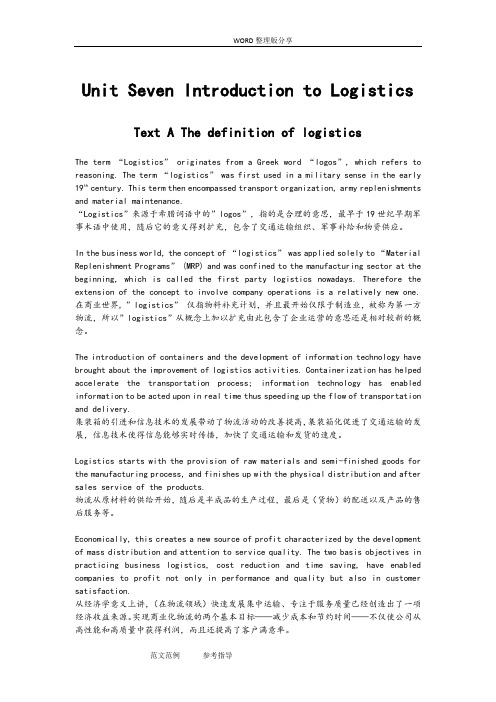
Unit Seven Introduction to Logistics Text A The definition of logisticsThe term “Logistics” originates from a Greek word “logos”, which refers to reasoning. The term “logistics” was first used in a military sense in the early 19th century. This term then encompassed transport organization, army replenishments and material maintenance.“Logistics”来源于希腊词语中的”logos”,指的是合理的意思,最早于19世纪早期军事术语中使用,随后它的意义得到扩充,包含了交通运输组织、军事补给和物资供应。
In the business world, the concept of “logistics”was applied solely to “Material Replenishment Programs”(MRP) and was confined to the manufacturing sector at the beginning, which is called the first party logistics nowadays. Therefore the extension of the concept to involve company operations is a relatively new one. 在商业世界, ”logistics”仅指物料补充计划,并且最开始仅限于制造业,被称为第一方物流,所以”logistics”从概念上加以扩充由此包含了企业运营的意思还是相对较新的概念。
交通运输与物流专业英语(Unite 3)中英文
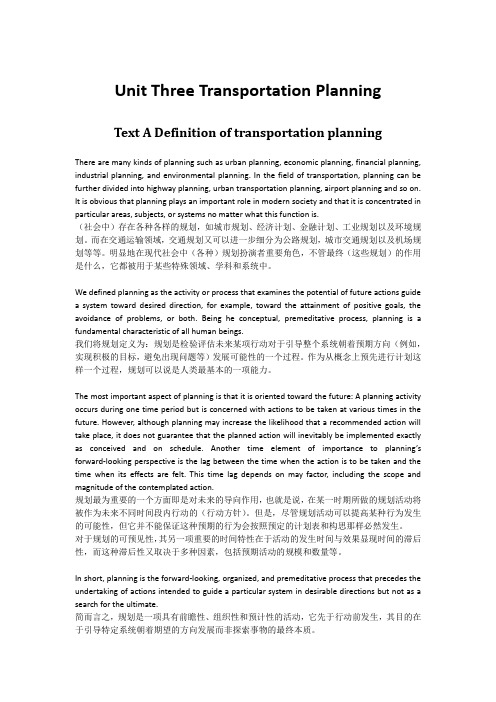
Unit Three Transportation PlanningText A Definition of transportation planningThere are many kinds of planning such as urban planning, economic planning, financial planning, industrial planning, and environmental planning. In the field of transportation, planning can be further divided into highway planning, urban transportation planning, airport planning and so on. It is obvious that planning plays an important role in modern society and that it is concentrated in particular areas, subjects, or systems no matter what this function is.(社会中)存在各种各样的规划,如城市规划、经济计划、金融计划、工业规划以及环境规划。
而在交通运输领域,交通规划又可以进一步细分为公路规划,城市交通规划以及机场规划等等。
明显地在现代社会中(各种)规划扮演者重要角色,不管最终(这些规划)的作用是什么,它都被用于某些特殊领域、学科和系统中。
We defined planning as the activity or process that examines the potential of future actions guide a system toward desired direction, for example, toward the attainment of positive goals, the avoidance of problems, or both. Being he conceptual, premeditative process, planning is a fundamental characteristic of all human beings.我们将规划定义为:规划是检验评估未来某项行动对于引导整个系统朝着预期方向(例如,实现积极的目标,避免出现问题等)发展可能性的一个过程。
物流专业英语Unit_Seven
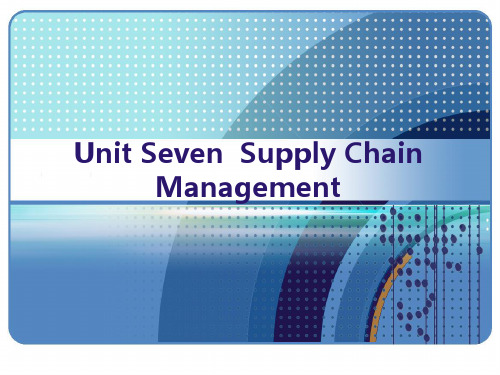
Introduction
❖ 1One of the most significant changes of modern business management is that individual businesses no longer compete as sole entities, but rather as supply chains. Business management has entered the era of internet work competition. Instead of brand versus brand or store versus store, it is now suppliers-brand-store versus suppliers brand store, or supply chain versus supply chain. In this competitive environment, the final success of the single business will depend on management’s ability to integrate the company’s network of business relationships. (Christopher, 1998)
❖ is typically an organization that buys from producers and sells to consumers. In addition to product promotion and sales, other functions the distributor performs are inventory management, warehouse operation, product transportation as well as customer support and post-sales service.
交通运输与物流专业英语中英文
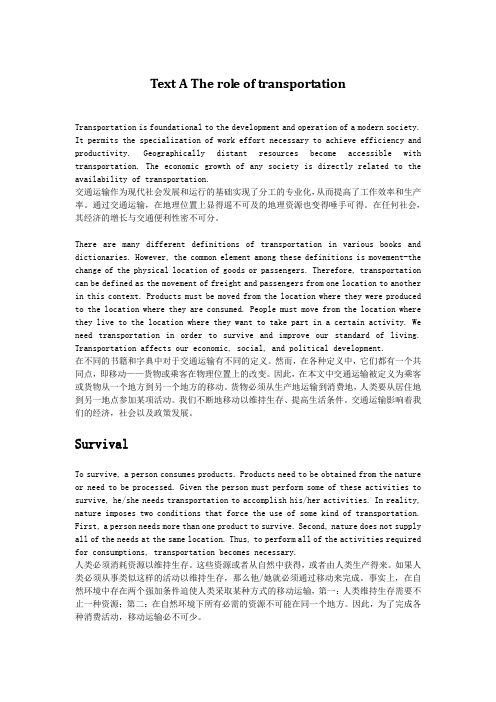
Text A The role of transportationTransportation is foundational to the development and operation of a modern society. It permits the specialization of work effort necessary to achieve efficiency and productivity. Geographically distant resources become accessible with transportation. The economic growth of any society is directly related to the availability of transportation.交通运输作为现代社会发展和运行的基础实现了分工的专业化,从而提高了工作效率和生产率。
通过交通运输,在地理位置上显得遥不可及的地理资源也变得唾手可得。
在任何社会,其经济的增长与交通便利性密不可分。
There are many different definitions of transportation in various books and dictionaries. However, the common element among these definitions is movement-the change of the physical location of goods or passengers. Therefore, transportation can be defined as the movement of freight and passengers from one location to another in this context. Products must be moved from the location where they were produced to the location where they are consumed. People must move from the location where they live to the location where they want to take part in a certain activity. We need transportation in order to survive and improve our standard of living. Transportation affects our economic, social, and political development.在不同的书籍和字典中对于交通运输有不同的定义。
Lesson 7 The Brakes

Lesson 7 TheBrakes The brakes may also be operated by mechanical linkages from the foot pedal and hand brake lever. mechanical linkage 机械连接 制动器也可以用制动踏板 制动手柄的机械制动装置操纵 制动踏板和 的机械制动装置操纵。 制动器也可以用制动踏板和制动手柄的机械制动装置操纵。 Common practice is to operate both front and rear brakes hydraulically with a secondary mechanical system operating the rear brakes only from the hand lever. 通常惯例是前、后制动器均为液压操纵,同时仅仅利用手柄的 仅仅利用手柄的辅助机 通常惯例是前、后制动器均为液压操纵,同时仅仅利用手柄的辅助机 械系统来操纵后制动器 来操纵后制动器。 械系统来操纵后制动器。 One of the great advantages of hydraulic operation is that the system is self-balancing, which means that the same pressure is automatically produced at all four brakes, whereas mechanical linkages have to be very carefully adjusted for balance. 液压操纵的最大优点之一是系统的自动平衡(自动调节) 液压操纵的最大优点之一是系统的自动平衡(自动调节),这就意味 着所有的四个制动器自动产生相等的压力, 着所有的四个制动器自动产生相等的压力,而机械传动装置必须经过 非常仔细的调整才能达到平衡。 非常仔细的调整才能达到平衡。
物流专业英语-Unit-7-E-business-and-its-application-in-logistics-第三版新编

Logistics is closely related to e-business; the latter definitely has a huge impact on the former. The future development of logistics will be tightly inseparable from e-business.
E-business, the output of information and networks of the 20th century, has drawn people’s attention extensively thanks to its ever-changing development. Any one transaction in e-business contains a number of primary “flows”, namely flows of information, business, finance and goods.
电 子 商 务 , 又 称 为 e-commerce,
是指通过电子手段并用数字数据来 处理商业交易。
课堂教学之——
Step 1 单词领读
➢ 由教师当堂领读生词 ➢ 纠正学生的发音 ➢ 领读完之后给学生留出5分钟的
时间来温习单词。
课堂教学之——
Step 2 重点内容
➢ 掌握核心术语 ➢ 学习时间5分钟
课堂教学之——
Step 3 难点学习
➢ 理解并背诵核心概念 ➢ 学习时间5分钟
课堂教学之——
交通运输与物流专业英语Unite中英文
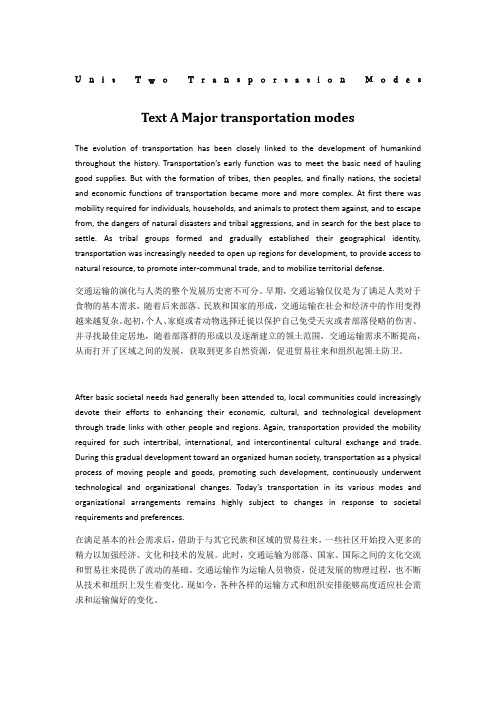
U n i t T w o T r a n s p o r t a t i o n M o d e s Text A Major transportation modesThe evolution of transportation has been closely linked to the development of humankind throughout the history. Transportation’s early function was to meet the basic need of hauling good supplies. But with the formation of tribes, then peoples, and finally nations, the societal and economic functions of transportation became more and more complex. At first there was mobility required for individuals, households, and animals to protect them against, and to escape from, the dangers of natural disasters and tribal aggressions, and in search for the best place to settle. As tribal groups formed and gradually established their geographical identity, transportation was increasingly needed to open up regions for development, to provide access to natural resource, to promote inter-communal trade, and to mobilize territorial defense.交通运输的演化与人类的整个发展历史密不可分。
unit seven
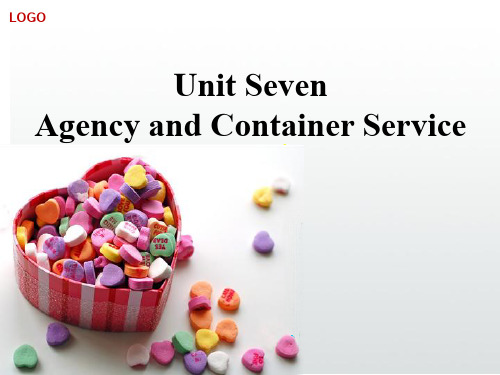
• The consignment is urgently required, so your prompt attention will be appreciated.
• 这批货物为顾客急需,故请即时交货。
2020/1/13
• New words and Expressions:
• items
物品
• order
订购,定制
• collection 收藏品,收集的东西,收货
• consignment 托付货物,托卖货物
• mark
在...留下痕迹;标出
• invoice 发票,开...的发票
2020/1/13
triplicate 三倍的,三重的,三乘的,三分之一
观察,研究,遵守,遵循
• cover
覆盖,all shortly have a consignment of electric shavers, weighing about 20 kg, for a customer in Damascus, which we wish to send by air from London. 我们即将有一批重约20公斤的电动剃须刀,打 算送给一位大马士革的顾客,我们希望能以空 运由伦敦运出。
• 由公路运送下述几箱货物给您,以便由7月25 日起航的贸易王子号运至亚历山大港。
2020/1/13
• 4 cases of crockery, marked , JR numbers 1—4
• 四箱陶器,标记为 JR ,编号1-4。 • The completed shipping form is enclosed,
交通运输与物流专业英语(Unite 8)中英文
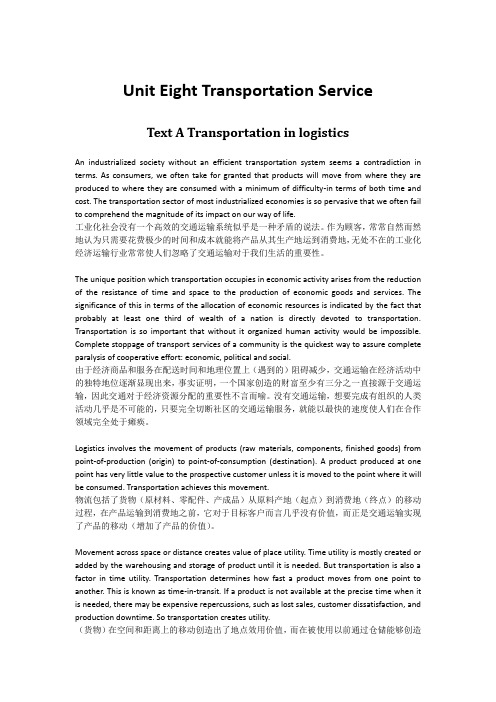
Unit Eight Transportation ServiceText A Transportation in logisticsAn industrialized society without an efficient transportation system seems a contradiction in terms. As consumers, we often take for granted that products will move from where they are produced to where they are consumed with a minimum of difficulty-in terms of both time and cost. The transportation sector of most industrialized economies is so pervasive that we often fail to comprehend the magnitude of its impact on our way of life.工业化社会没有一个高效的交通运输系统似乎是一种矛盾的说法。
作为顾客,常常自然而然地认为只需要花费极少的时间和成本就能将产品从其生产地运到消费地,无处不在的工业化经济运输行业常常使人们忽略了交通运输对于我们生活的重要性。
The unique position which transportation occupies in economic activity arises from the reduction of the resistance of time and space to the production of economic goods and services. The significance of this in terms of the allocation of economic resources is indicated by the fact that probably at least one third of wealth of a nation is directly devoted to transportation. Transportation is so important that without it organized human activity would be impossible. Complete stoppage of transport services of a community is the quickest way to assure complete paralysis of cooperative effort: economic, political and social.由于经济商品和服务在配送时间和地理位置上(遇到的)阻碍减少,交通运输在经济活动中的独特地位逐渐显现出来,事实证明,一个国家创造的财富至少有三分之一直接源于交通运输,因此交通对于经济资源分配的重要性不言而喻。
上海海事大学国际物流Chapter 7 International Commercial Documents
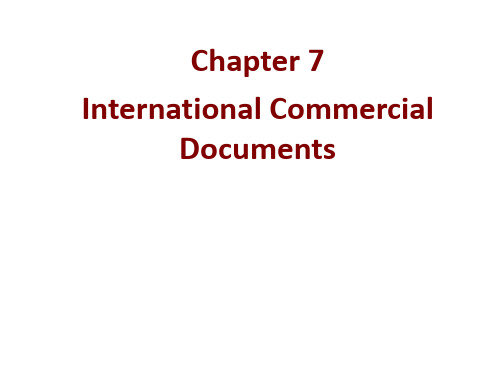
上海海事大学 高洁
Export Documents
Export Taxes
• Several countries require exporters to pay an export tax on certain commodities. • It can make sense in the case where the goods are minerals in short supply, or when the product has been heavily subsidized by the government.
上海海事大学 高洁
HS编码查询 /
Invoices
Consular Invoice
• Commercial invoice printed on stationery(纸) of importing country’s Consulate, and stamped by Consulate. • Necessary for exports to some countries.
上海海事大学 高洁
上海海事大学 高洁
Invoices
Commercial Invoice
• The invoice sent by the seller to the buyer, detailing the goods purchased and the amount due. • Depending on the Terms of Payment, it may be sent directly to the importer(with the merchandise) or indirectly, through the banking channels.
物流职业英语unit 7
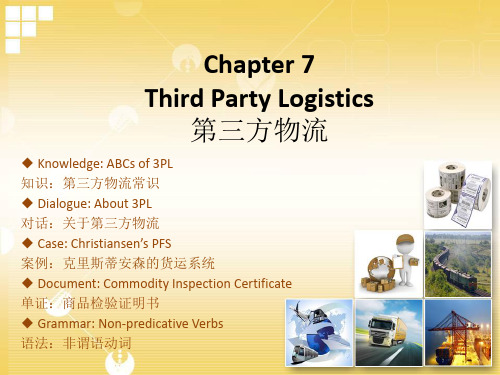
Exercises
Ⅰ. Based on the above passage, choose the best answer for each of the following. 1. Many people are unfamiliar __________ the term“3PL”. B A. to B. with C. for D. at 2. It is not clear exactly who coined the term 3PL. Here “coined” means “__________ ”. C A. metal money B. make metal into coins C. invented D. coined money 3.We can trace its history back __________ the 1970’s and 80’s. D A. at B. for C. with D. to 4. 3PL companies __________ the business by integrating their warehousing with A transportation services. A. expand B. cover C. supply D. provide 5. They _______ the freight market and paved the way for the 3PL industry. B A. deregulate B. deregulated C. deregulation D. deregulatory
Chapter 7 Third Party Logistics 第三方物流
◆ Knowledge: ABCs of 3PL 知识:第三方物流常识 ◆ Dialogue: About 3PL 对话:关于第三方物流 ◆ Case: Christiansen’s PFS 案例:克里斯蒂安森的货运系统 ◆ Document: Commodity In Grammar: Non-predicative Verbs 语法:非谓语动词
物流专业英语Unit_Seven

❖ 5Suppliers:They are organizations that provide goods and/or services to a purchasing organization (a manufacturer or a distributor).
❖ 6Manufacturers (producers):They are the companies that make a product. This includes companies that are producers of raw materials and companies that are producers of finished goods. Producers can also create products that are intangible items such as music, entertainment, software and design.
Supply Chain Participants
❖ 4In fact, the participants of a supply chain include all companies or organizations with whom the focal company has business relationship directly or indirectly through its suppliers or end users. In any given supply chain, there is some combination of companies who perform different functions. There are companies that are suppliers, manufacturers, distributors or wholesalers, retailers, and companies or individuals who are the customers, or the final consumers of a product. What’s more, there will be other companies that are service providers that provide a range of needed services. However, the basic participants of a supply chain can be summarized as:
物流专业英语 seven

Sample 3 Advice of shipment to forwarding agent in buyer’s country (Alexandria)
May 11, 2008
Dear Mrs. Brown, Please note that we have shipped the following goods to you by S.S. Merchant Prince, which left Liverpool yesterday and is due to arrive at Alexandria on 9 August. Mark and Numbers Goods Gross Weight Value
Sample 2 Agent’s instruction to shipping company
July 1, 2008 Dear Mr. Smith We have today arranged for H J Cooper & Co. Ltd, Manchester, to forward to you by road, the following cases to be shipped to Alexandria by S.S. Merchant Prince on 25 July.JR JR 4 cases of crockery, marked , numbers 1—4 The completed shipping form is enclosed, together with 4 copies of the bill of lading. Please sign and return 3 copies of the bill and charge the amount to our account. Yours sincerely, Tom Smith (Mr.)
unit 7 transportation
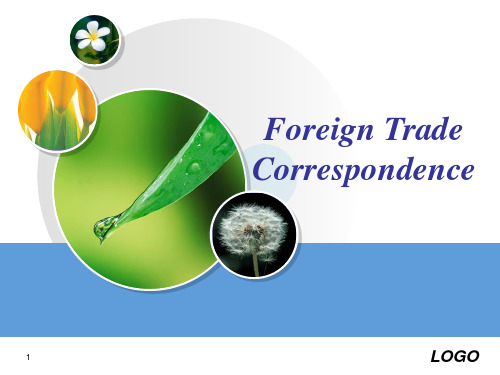
海洋运输
一、海洋运输船泊的经营方式 (一) 班轮运输 Liner Transport • 特点
-
四固定:固定航线、固定港口、固定 船期、相对固定的运费率
- 一负责:船公司负责配载装卸货物, 并负责装卸费用。 成交量少、批次多、交接港口分散的货物比较适合 采用班轮运输。我国出口商品中的纺织品、食品、 工艺品、杂货类通常利用班轮运输。
Shipment on or before July 30, 2003.
Shipment not later than July 30, 2003.
Shipment within 60 days after receipt of L/C. The relevant L/C should reach the seller not later than …… Shipment as soon as possible. (immediately , promptly)
6
7.1.2 Modes of Transportation
• Sea transport /Marine Transport • Air transport • Rail transport and Road transport • Parcel post transport • Multi-model transport • Land-bridge transport Question: Which one will the exporter choose when he delivers goods to the buyer ?
装运时间的规定 1、明确规定具体的时间,规定明确的装运月份 或季度。含义明确,不易产生误解,在国际贸 易中普遍采用。 2、规定收到信用证后一定时间内装运。 3、收到信汇、票汇或电汇后若干天装运。 4、笼统规定近期装运。易产生分歧,一般不宜 采用。
- 1、下载文档前请自行甄别文档内容的完整性,平台不提供额外的编辑、内容补充、找答案等附加服务。
- 2、"仅部分预览"的文档,不可在线预览部分如存在完整性等问题,可反馈申请退款(可完整预览的文档不适用该条件!)。
- 3、如文档侵犯您的权益,请联系客服反馈,我们会尽快为您处理(人工客服工作时间:9:00-18:30)。
【最新整理,下载后即可编辑】Unit Seven Introduction to LogisticsText A The definition of logisticsThe term “Logistics”originates from a Greek word “logos”, which refers to reasoning. The term “logistics” was first used in a military sense in the early 19th century. This term then encompassed transport organization, army replenishments and material maintenance. “Logistics”来源于希腊词语中的”logos”,指的是合理的意思,最早于19世纪早期军事术语中使用,随后它的意义得到扩充,包含了交通运输组织、军事补给和物资供应。
In the business world, the concept of “logistics” was applied solely to “Material Replenishment Programs” (MRP) and was confined to the manufacturing sector at the beginning, which is called the first party logistics nowadays. Therefore the extension of the concept to involve company operations is a relatively new one.在商业世界, ”logistics”仅指物料补充计划,并且最开始仅限于制造业,被称为第一方物流,所以”logistics”从概念上加以扩充由此包含了企业运营的意思还是相对较新的概念。
The introduction of containers and the development of information technology have brought about the improvement of logistics activities. Containerization has helped accelerate the transportation process; information technology has enabled information to be acted upon in real time thus speeding up the flow of transportation and delivery.集装箱的引进和信息技术的发展带动了物流活动的改善提高,集装箱化促进了交通运输的发展,信息技术使得信息能够实时传播,加快了交通运输和发货的速度。
Logistics starts with the provision of raw materials and semi-finished goods for the manufacturing process, and finishes up with the physical distribution and after sales service of the products.物流从原材料的供给开始,随后是半成品的生产过程,最后是(货物)的配送以及产品的售后服务等。
Economically, this creates a new source of profit characterized by the development of mass distribution and attention to service quality. The two basis objectives in practicing business logistics, cost reduction and time saving, have enabled companies to profit not only in performance and quality but also in customer satisfaction.从经济学意义上讲,(在物流领域)快速发展集中运输、专注于服务质量已经创造出了一项经济收益来源。
实现商业化物流的两个基本目标——减少成本和节约时间——不仅使公司从高性能和高质量中获得利润,而且还提高了客户满意率。
There are various definitions of different editions. The term was defined as follow:不同书刊版本对物流的定义不同,其定义有如下几种:Logistics is the procurement, maintenance, distribution, and replacement of personnel and material.物流就是采购、供给、配送以及人员物资的更换。
Logistics is the science of planning, organizing and managing activities that provides goods or services.物流就是通过科学地规划、组织和管理以提供货物及服务。
Logistics is defined as a business-planning framework for themanagement of material, service, information and capital flows. It includes the increasingly complex information, communication and control systems required in today’s business environment.物流被定义为对物料、服务、信息和资金流进行管理的商业计划体系,它包括了当今商业环境中日益复杂的信息、交流和控制系统。
Logistics is the process of planning, implementing, and controlling the efficient, cost effective flow and storage of raw materials, in-process inventory, finished goods and related information from point of origin to point of consumption for the purpose of meeting customer requirements.物流是一个过程,它包括了计划,实施,控制效率、成本效益流、原材料的存储、工序内存货、产成品、从产地到消费地的相关信息等以满足客户需求。
From these definitions logistics can be briefly described like this: “Logistics means having the right thing, at the right place, at the right time.” At its heart, logistics deals with satisfying the customer.从以上定义中可将物流简要的描述为:物流指的是使正确的东西在正确的时间位于正确的地点,其核心是满足消费者的需求。
In a more practical sense, logistics refers to the systematic management of the various activities required to move benefits from their point of production to the customer. But logistics encompasses much more than just the transport of goods.从更切实际意义角度讲,物流指的是对各种活动进行系统的管理,以使(产品本身的)价值从其生产地转移到消费者手中。
物流所包含的意思远非货物运输。
The concept of benefits goes beyond the product or service itself toinclude issues regarding timing, quantity, supporting services, location and cost. So a basic definition of logistics is the continuous process of meeting customer needs by ensuring the availability of the right benefits at the right time and right place for a right price for the right customer. These concepts apply equally well to for-profit industries and non-profit organizations.(对消费者而言)“价值”这一概念超越了产品或服务本身,更包括了与时间、数量、配套服务、地点和成本相关的问题。
所以,物流的一个基本定义是指不断满足消费者需求,保证(货物)价值在正确的时间、正确的地点以正确的价格到正确的顾客手中。
这一概念同时适用于盈利组织与非盈利组织。
However, logistics can mean different things to different organization. Some organizations are more concerned with production of the benefits; so their management focuses on the flow of raw materials into the production process rather than on delivering the final goods to the user. Alternatively, some organizations are much more concerned with the flow of finished goods from the end of the production line to the ultimate customer. Finally, some organizations view logistics as embracing both materials management and physical distribution.然而,物流对于不同的组织而言意味着不同的东西。
